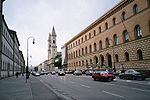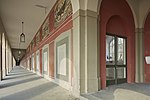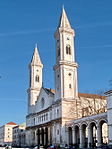Ministry of War (Kingdom of Bavaria)
1808 establishments in BavariaFormer defence ministriesHistory of MunichKingdom of BavariaLeo von Klenze buildings ... and 4 more
MaxvorstadtMilitary of BavariaMinistries established in 1808Politics of Bavaria

The Ministry of War (German: Kriegsministerium) was a ministry for military affairs of the Kingdom of Bavaria, founded as Ministerium des Kriegswesens on October 1, 1808 by King Maximilian I Joseph of Bavaria. It was located on the Ludwigstraße in Munich. Today the building, which was built by Leo von Klenze between 1824 and 1830, houses the Bavarian public record office, Bayerisches Hauptstaatsarchiv und Staatsarchiv München.
Excerpt from the Wikipedia article Ministry of War (Kingdom of Bavaria) (License: CC BY-SA 3.0, Authors, Images).Ministry of War (Kingdom of Bavaria)
Ehrenhof, Munich Maxvorstadt
Geographical coordinates (GPS) Address Nearby Places Show on map
Geographical coordinates (GPS)
| Latitude | Longitude |
|---|---|
| N 48.146388888889 ° | E 11.579722222222 ° |
Address
Staatsarchiv München
Ehrenhof
80539 Munich, Maxvorstadt
Bavaria, Germany
Open on Google Maps








